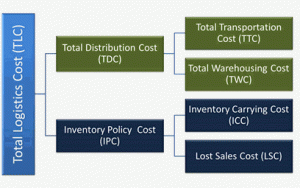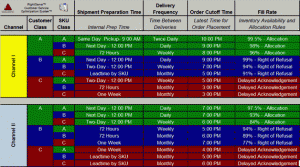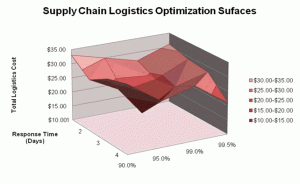An optimization statement is comprised of two components – an objective function and constraints. Isolated to inventory, the optimization becomes finding the inventory level that yields the best possible financial performance for the business and supply chain subject to fill rate, response time, shipping frequency, and storage capacity constraints.
The RightStock™ model uses a menu of objective functions for inventory decision optimization. They are all related to financial performance, and include the impact of inventory and fill rate on revenue, expense, and capital. (This is a major departure from most supply chain philosophies, tools, and metrics which typically only consider the impact of decisions on expenses or operational performance indicators.) RightStock™ objective functions include maximizing Return on Invested Capital (ROIC), maximizing Inventory Value Added™ (IVA), minimizing Inventory Policy Cost (IPC), and maximizing Gross Margin Return on Inventory (GMROI). There will be a much more comprehensive explanation of these objective functions in section 2.6.
Inventory Constraints
If all we had was an objective function, optimization would be easy. Admittedly facetious, but regrettably common, here’s a storyline that is played out in many companies. Let’s consider each of the total logistics cost components, independently. First, transportation. Transportation has become so expensive and complex that we may just decide to stop trying. Fuel costs. Regulatory hassles. Poorly performing carriers. The list goes on. Second, warehousing. All the JIT, Lean, and Six Sigma books suggest that warehousing is non-value added, and just plain bad for business. Let’s close the warehouses. Third, inventory carrying. Even though inventory is still an asset in accounting, we all know it’s a liability (borderline illegal in some companies) and politically incorrect in the current JIT, Lean, Six Sigma environment. We need to stop carrying inventory. Since there is no inventory, there will be no customers, so lost sales cost is eliminated. These all work together to completely eliminate total logistics cost and the inventory that goes with it. We win, right? Wrong!

Total Logistics Cost Elements for Optimization
In addition to common sense, what should prohibit an organization from going down that road to ruin? A customer service policy (CSP). A RightChain™ Customer Service Policy is segmented by channel, ABC customer class within a channel, commodity, and SKU class within a commodity (Figure 1.4). The CSP establishes targets which must be met for fill rate, response time, delivery frequency, delivery quality, packaging, and any other stipulated dimension of customer service. Those requirements serve as constraints in supply chain logistics optimization. An example supply chain logistics optimization statement from a recent service parts client follows.

Multi-Channel Customer Service Policy
Objective Function
- Minimize Total Logistics Cost
Constraints
- Fill Rate > 90%
- Response Time < 96 Hours
- Delivery Frequency = 3x per Week
- Shipping Accuracy > 99.7%
An illustration of the optimization is below. Note that the customer service policy yielding the lowest total logistics cost is a response time of 3 days and a fill rate of 99%. (That is not always the case and just happened to be for one particular SKU for this particular client.) The tricky part is that as fill rate increases, inventory carrying cost, warehousing costs, and potentially transportation costs increase while lost sales costs decrease. Those dynamics and interdependencies are reflected on one axis. As response time decreases, transportation costs, warehousing costs, and potentially inventory carrying costs increase (depending on whether the response time requirement is met via more expensive transportation or more warehousing close to the customer); but lost sales cost decrease. Those dynamics and interdependencies are reflected on the other axis.

Supply Chain Logistics Optimization Surfaces
A strictly inventory optimization statement would include one or more of the following objective functions and one or more of the following constraints. (Each will be explained in much more detail as we proceed through the book.)
Inventory Objective Function Candidates
- Maximize Gross Margin Return on Inventory (GMROI)
- Maximize Inventory Value Added™ (IVA)
- Minimize Inventory Policy Cost™ (IPC)
Inventory Optimization Constraints
- Fill Rate > Target
- Response Time < Target
- Shipping Frequency > Target
- Inventory < Storage Capacity
Determining and implementing the inventory level that satisfies the required constraints and yields the best financial performance is inventory optimization.








Bài viết liên quan: